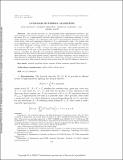A Parallel Butterfly Algorithm
Author(s)
Poulson, Jack; Demanet, Laurent; Maxwell, Nicholas; Ying, Lexing
DownloadPoulson-2014-A parallel butterfly.pdf (242.4Kb)
PUBLISHER_POLICY
Publisher Policy
Article is made available in accordance with the publisher's policy and may be subject to US copyright law. Please refer to the publisher's site for terms of use.
Terms of use
Metadata
Show full item recordAbstract
The butterfly algorithm is a fast algorithm which approximately evaluates a discrete analogue of the integral transform $\int_{\mathbb{R}^d} K(x,y) g(y) dy$ at large numbers of target points when the kernel, $K(x,y)$, is approximately low-rank when restricted to subdomains satisfying a certain simple geometric condition. In $d$ dimensions with $O(N^d)$ quasi-uniformly distributed source and target points, when each appropriate submatrix of $K$ is approximately rank-$r$, the running time of the algorithm is at most $O(r^2 N^d \log N)$. A parallelization of the butterfly algorithm is introduced which, assuming a message latency of $\alpha$ and per-process inverse bandwidth of $\beta$, executes in at most $O(r^2 \frac{N^d}{p} \log N + (\beta r\frac{N^d}{p}+\alpha)\log p)$ time using $p$ processes. This parallel algorithm was then instantiated in the form of the open-source \textttDistButterfly library for the special case where $K(x,y)=\exp(i \Phi(x,y))$, where $\Phi(x,y)$ is a black-box, sufficiently smooth, real-valued phase function. Experiments on Blue Gene/Q demonstrate impressive strong-scaling results for important classes of phase functions. Using quasi-uniform sources, hyperbolic Radon transforms, and an analogue of a three-dimensional generalized Radon transform were, respectively, observed to strong-scale from 1-node/16-cores up to 1024-nodes/16,384-cores with greater than 90% and 82% efficiency, respectively.
Date issued
2014-02Department
Massachusetts Institute of Technology. Department of MathematicsJournal
SIAM Journal on Scientific Computing
Publisher
Society for Industrial and Applied Mathematics
Citation
Poulson, Jack, Laurent Demanet, Nicholas Maxwell, and Lexing Ying. “A Parallel Butterfly Algorithm.” SIAM Journal on Scientific Computing 36, no. 1 (February 4, 2014): C49–C65.© 2014, Society for Industrial and Applied Mathematics.
Version: Final published version
ISSN
1064-8275
1095-7197